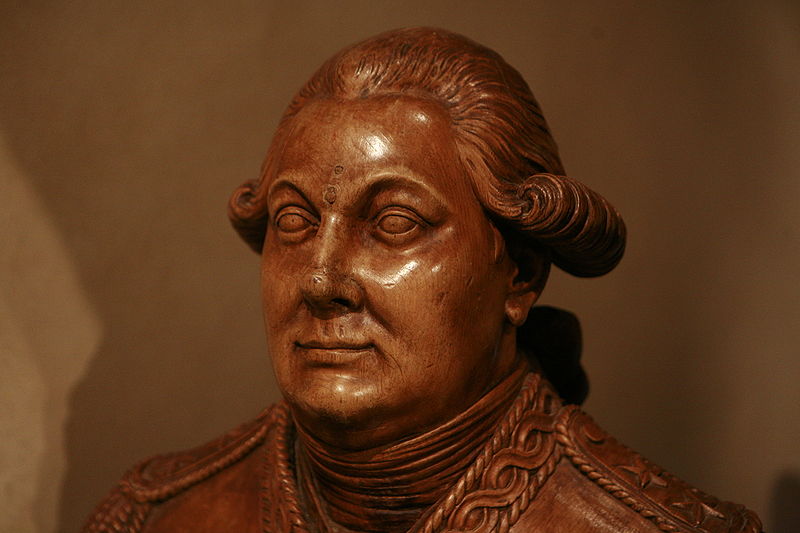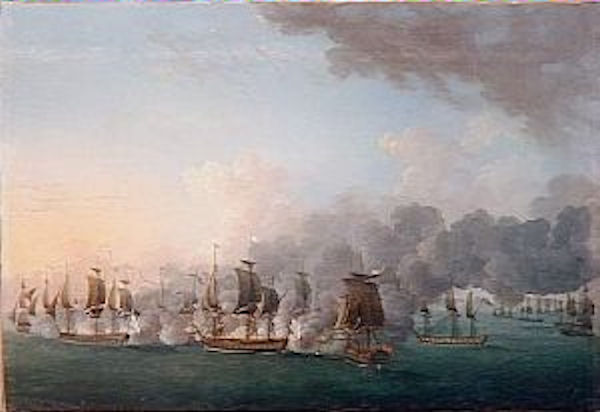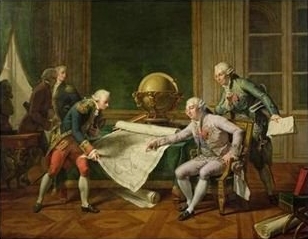<Back to Index>
- Explorer Jean François de Galaup, Comte de Lapérouse, 1741
- Poet Edgar Lee Masters, 1868
- King of France and of Navarre Louis XVI, 1754
PAGE SPONSOR
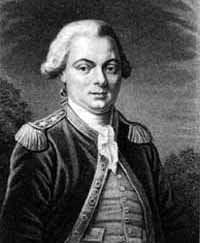
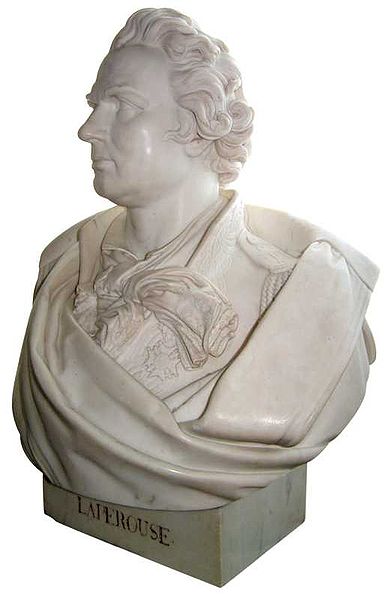
Jean François de Galaup, comte de Lapérouse (23 August 1741 – 1788?) was a French Navy officer and explorer whose expedition vanished in Oceania.
Jean-François de Galaup was born near Albi, France. Lapérouse was the name of a family property that he added to his name. He studied in a Jesuit college and entered the naval college in Brest when he was fifteen. In 1757 he was posted to the Célèbre and participated in a supply expedition to Louisbourg in New France. He was in a second supply expedition in 1758 to that besieged fortress that was forced to make a circuitous route around Newfoundland to avoid British patrols. In 1759 he was wounded in the Battle of Quiberon Bay, where he was serving aboard the Formidable. He was captured and briefly imprisoned before being paroled back to France; he was formally exchanged in December 1760. He participated in a 1762 attempt by the French to gain control of Newfoundland, escaping with the fleet when the British arrived in force to drive them out.
Following the Franco-American alliance, he fought against the Royal Navy off the American coast, and victoriously led the frigate Astree in the Naval battle of Louisbourg, 21 July 1781. He was promoted to rank of commodore when he defeated the English frigate Ariel in the West Indies. In August 1782 he made his name by capturing two English forts (Prince of Wales Fort and York Fort) on the coast of Hudson Bay, but allowed the survivors, including Governor Samuel Hearne of
Prince of Wales Fort, to sail off to England in exchange for a promise
to release French prisoners held in England. The next year his family
finally consented to his marriage to Louise-Eléonore Broudou, a
young creole of modest origins whom he met on Ile de France (present-day Mauritius). After the Treaty of Paris, Lapérouse was appointed in 1785 by Louis XVI and his minister of marine, the Marquis de Castries,
to lead an expedition around the world. Louis XVI and his court had
been stimulated by a proposal from the merchant adventurer William
Bolts, who had earlier tried unsuccessfully to interest Louis’s
brother-in-law, the Austrian Emperor Joseph II (brother of Queen Marie
Antoinette), in a similar voyage. The French court adopted the concept
(though not its author, Bolts), leading to the dispatch of the
Lapérouse expedition. Charles Pierre Claret de Fleurieu,
Directeur des Ports et Arsenaux, stated in the draft of the memorandum
on the expedition he submitted to the King: “the utility which may
result from a voyage of discovery … has made me receptive to the views
put to me by Mr. Bolts relative to this enterprise”. But, Fleurieu
explained to the King: “I am not proposing at all, however, the plan
for this voyage as it was conceived by Mr. Bolts”. Its aims were to complete the Pacific discoveries of James Cook (whom
Lapérouse greatly admired), correct and complete maps of the
area, establish trade contacts, open new maritime routes and enrich
French science and scientific collections. His ships were the Astrolabe (under Fleuriot de Langle) and the Boussole, both 500 tons. They were storeships, reclassified as frigates for
the occasion. Their objectives were geographic, scientific,
ethnological, economical (looking for possibilities of whaling or fur
trading), and political (the eventual establishment of French bases or
colonial cooperation with their Spanish allies in the Philippines).
They were to explore both the north and south Pacific, including the
coasts of the Far East and of Australia, and send back reports through
existing European outposts in the area. As early as March 1785, Lapérouse proposed that Paul Monneron, who had been chosen as the expedition's chief engineer, go to London to find out about the latest conclusions on the anti-scurvy measures
recommended by Cook and the exchange items used by Cook in his dealings
with the native peoples, and to buy scientific instruments of English
manufacture. The best-known figure on Cook's mission, Joseph Banks, intervened at the Royal Society to
obtain him two inclining compasses that had belonged to Cook, and
Monneron also bought scientific instruments figuring on a list produced
by Fleurieu, having recourse to the largest English firms, particularly Ramsden. He even surpassed Fleurieu's directives by acquiring two sextants of a new type. Lapérouse
tried to get on well with the Pacific islanders, and was well-liked by
his men. Among his 114-man crew there were ten scientists: Dagelet, an
astronomer and mathematician; Robert de Lamanon, a geologist; La Martinière, a botanist; a physicist; three naturalists; and three illustrators, Gaspard Duché de Vancy and an uncle and nephew named Prévost. Another of the scientists was Jean-André Mongez. Even both chaplains were scientifically schooled. One of the men who applied for the voyage was a 16-year-old Corsican named Napoléon Bonaparte.
Bonaparte, a second lieutenant from Paris's military academy at the
time, made the preliminary list but he was ultimately not chosen for
the voyage list and remained behind in France. At the time Bonaparte
was interested in serving in the navy rather than army because of his
proficiency in mathematics and artillery, both valued skills on
warships. (One can only speculate on the course history might have
taken had Lapérouse selected young Napoleon for the trip.) Copying
the work methods of Cook's scientists, the scientists on this voyage
would base their calculations of longitude on precision watches and the
distance between the moon and the sun followed by theodolite
triangulations or bearings taken from the ship, the
same as those taken by Cook to produce his maps of the Pacific islands.
As regards geography, Lapérouse decisively showed the rigour and
safety of the methods proven by Cook. From his voyage, the resolution
of the problem of longitude was evident and mapping attained a
scientific precision. Impeded (as Cook had been) by the continual mists
enveloping the northwestern coast of America, he nevertheless did not
succeed any better in producing complete maps, though he managed to
fill in some of the gaps. He and his 220 men left Brest on 1 August 1785, rounded Cape Horn, investigated the Spanish colonial government in Chile, and, by way of Easter Island (where he arrived on 9 April 1786) and Hawaii (where he became the first European to set foot on the island of Maui), sailed on to Alaska, where he landed near Mount St. Elias in late June 1786 and
explored the environs. On 13 July 1786 a barge and two longboats,
carrying 21 men, were lost in the heavy currents of the bay called Port des Français by Lapérouse, but now known as Lituya Bay. The men visited with theTlingit tribe. Next, he headed south, exploring the northwest coast all the way to Monterey. Along the way, he explored the outer islands of British Columbia (August 10 – 30) and reportedly observed the only historical eruption of Mount Shasta on 7 September 1786. He arrived in Monterey on 14 September 1786. where he examined the Spanish settlements and made critical notes on the treatment of the Indians in the Franciscan missions. He again crossed the Pacific Ocean in 100 days, arriving at Macau, where he sold the furs acquired in Alaska, dividing the profits among his men. The next year, on 9 April 1787, after a visit to Manila, he set out for the northeast Asian coasts. He saw the island of Quelpart (Cheju), which had been visited by Europeans only once before when a group of
Dutchmen shipwrecked there in 1635. He visited the mainland coast of Korea, then crossed over to Oku-Yeso (Sakhalin). The inhabitants had drawn him a map, showing their country, Yeso (also Yezo, now called Hokkaidō) and the coasts of Tartary (mainland Asia). Lapérouse wanted to sail through the channel between Sakhalin and Asia, but failed, so he turned south, and sailed through La Pérouse Strait (between Sakhalin and Hokkaidō), where he met the Ainu, explored the Kuriles, and reached Petropavlovsk (on Kamchatka peninsula) on 7 September 1787. Here they rested from their trip, and enjoyed the hospitality of the Russians and Kamchatkans. In letters received from Paris he was ordered to investigate the settlement the British were to erect in New South Wales. Barthélemy de Lesseps, the French vice consul at Kronstadt, who had joined the expedition as an interpreter, disembarked to bring the expedition's letters and documents to France, which he reached after a year-long, epic journey across Siberia and Russia. On 25 September 1791 Rear Admiral Bruni d'Entrecasteaux departed
Brest in search of Lapérouse. His expedition followed
Lapérouse's proposed path through the islands northwest of
Australia while at the same time making scientific and geographic
discoveries. In
May 1793, he arrived at the island of Vanikoro, which is part of the
Santa Cruz group of islands. D'Entrecasteaux thought he saw smoke
signals from several elevated areas on the island, but was unable to
investigate due to the dangerous reefs surrounding the island and had to leave. He died two months later. The botanist Jacques Labillardière, attached to the expedition, eventually returned to France and published his account, Relation du Voyage à la Recherche de la Pérouse, in 1800. It was not until 1826 that an Irish captain, Peter Dillon, found enough evidence to piece together the events of the tragedy. In Tikopia (one
of the islands of Santa Cruz), he bought some swords he had reason to
believe had belonged to Lapérouse. He made enquiries, and found that they came from nearby Vanikoro, where two big ships had broken up. Dillon managed to obtain a ship in Bengal,
and sailed for Vanikoro where he found cannon balls, anchors and other
evidence of the remains of ships in water between coral reefs. He
brought several of these artifacts back to Europe, as did Dumont d'Urville in 1828. De Lesseps, the only member of the expedition still alive at the time, identified them as all belonging to the Astrolabe.
From the information Dillon received from the people on Vanikoro, a
rough reconstruction could be made of the disaster that struck
Lapérouse, which was confirmed by the find and search of the
shipwreck of the Boussole in 1964. In May 2005, the wreck was formally identified as that of the Boussole. The
2005 expedition was embarked aboard Jacques Cartier, a French naval
vessel. The ship supported a multi-discipline scientific team to
investigate the "Mystery of Lapérouse". The
mission was called "Opération Vanikoro - Sur les traces des
épaves de Lapérouse 2005". A further similar mission was
mounted in 2008. The
2008 expedition displayed a further commitment by the French nation,
alongside the New Caledonian association Salomon to further seek
answers to the mysteries of fate of Lapérouse. The 2008
expedition received the patronage of the President of France and
support and cooperation from the Ministry of Defense, The Ministry of
Higher Education & Research, and the Ministry of Culture &
Communication. Preparation for the expedition took 24 months and was
the 8th expedition enquiring after Lapérouse at Vanikoro island.
It brought together greater technological resources than before and
involved 2 ships, 52 crew members and 70 participants including almost
30 scientists and researchers. Between 16 September and 15 October
2008, two French Navy boats set out from Nouméa (New Caledonia)
for a voyage to Vanikoro, recreating that section of the final journey
of discovery made by Lapérouse. Both ships had been wrecked on the reefs, the Boussole first. The Astrolabe was unloaded and taken apart. A group of men, probably the survivors of the Boussole, were massacred by the local inhabitants. According to natives, surviving sailors built a two-masted craft from the wreckage of the Astrolabe,
and left westward about 9 months later, but what happened to them is
unknown. Also, two men, one a "chief" and the other his servant, had
remained behind, but had left Vanikoro a few years before Dillon
arrived.
His next stops were in the Navigator Islands (Samoa), on 6 December 1787. Just before he left, the Samoans attacked a group of his men, killing twelve of them, among whom were Lamanon and de Langle, commander of the Astrolabe. Twenty men were wounded. The expedition continued to Tonga and then to Australia, arriving off Botany Bay on 24 January 1788, just as Captain Arthur Phillip was attempting to move the colony from there to Sydney Cove in Port Jackson. The First Fleet was
unable to leave until 26 January because of a tremendous gale, which
also prevented Lapérouse's ships from entering Botany Bay. The
British received him courteously, and each captain, through their
officers, offered the other any assistance and supplies he may need. He and Phillip did not meet personally. Lapérouse sent his journals and letters to Europe with a British ship, the Sirius, obtained wood and fresh water, and on 10 March left for New Caledonia, Santa Cruz, the Solomons, the Louisiades, and the western and southern coasts of Australia.
Although he wrote that he expected to be back in France by June 1789,
neither he nor any of his men were seen again. Fortunately, before he
set sail, Lapérouse had sent the valuable written details of his
expedition to Paris where they were published posthumously.
